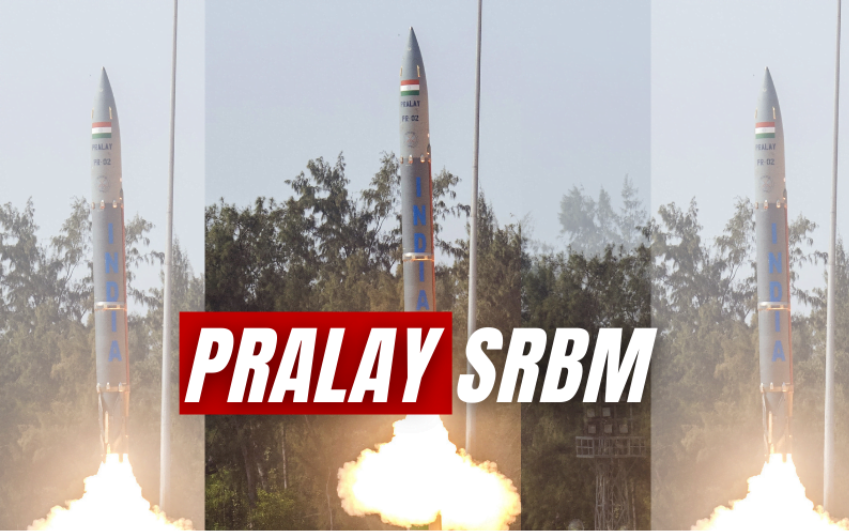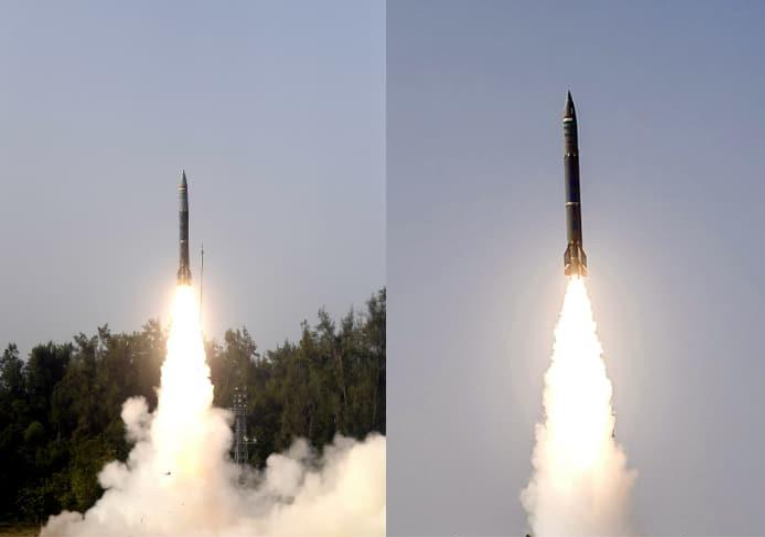KD
I’m Kiran, a content creator at Education Masters. I write and share informative articles on jobs, education updates, and career opportunities to help students and aspirants stay informed and succeed in their goals.
.jpg)
Pralay missile is a next-generation, short-range, surface-to-surface ballistic missile developed by India’s Defence Research and Development Organisation (DRDO). It is designed as a highly accurate, fast-reaction tactical missile capable of neutralizing high-value military targets in contested environments. Pralay missile is considered a significant addition to India’s theatre command and tactical deterrence capabilities, especially along sensitive borders. The missile uses advanced rocket-motor technology and sophisticated guidance to ensure precise strikes even against fortified and mobile targets. It is comparable to modern tactical ballistic missiles like China’s DF-12/M20.
The missile can carry multiple types of conventional warheads, including fragmentation, penetration, and high-explosive payloads, enabling flexible employment in battlefield roles. Its quasi-ballistic flight profile, terminal manoeuvring capabilities, and high speed make it difficult to intercept with enemy missile defence systems. Pralay missile is deployed as part of India’s Integrated Battle Groups (IBGs) and is intended to provide rapid offensive capability for short, intense conflicts.
|
Parameter |
Details |
|
Name |
Pralay missile |
|
Developed By |
DRDO (Defence Research and Development Organisation), India |
|
Category |
Short-Range Ballistic Missile (SRBM) |
|
Purpose / Role |
Tactical battlefield strike, neutralizing high-value targets, theatre deterrence |
|
Range |
Pralay missile range is 150–500 km (depending on warhead load) |
|
Propulsion |
Solid-fuel, dual-pulse rocket motor |
|
Warhead Options |
High-explosive, fragmentation, penetration, pre-formed fragments |
|
Payload Capacity |
500–1,000 kg warheads |
|
Accuracy |
High precision with advanced navigation and terminal guidance |
|
Guidance System |
INS + Satellite Navigation (GPS/IRNSS/GLONASS) with terminal manoeuvring |
|
Key Features |
Quasi-ballistic missile, difficult to intercept, high manoeuvrability, fast launch readiness |
|
Launch Platform |
Road-mobile Launcher (TEL) |
|
Speed |
Pralay missile speed is Hypersonic (high supersonic in terminal stage) |
|
Targets |
Enemy missile sites, airbases, logistics hubs, command centres, troop concentrations |
|
Status |
Successfully tested; approved for large-scale induction into the Indian Armed Forces (Army) |
Pralay missile was conceptualized to counter evolving regional threats and provide India with a modern, survivable, and hard-to-intercept tactical missile. Development started in the mid-2010s under DRDO to create a missile comparable to China’s DF-12/M20. The missile’s design incorporates lessons from previous DRDO programs such as Prahaar, Prithvi, and Agni-series technologies.
Pralay missile plays a crucial role in India’s Integrated Battle Group (IBG) strategy, offering rapid response options during short, intense conflicts. It allows the Army to target high-value assets deep inside enemy territory without escalating to longer-range strategic missiles.

The Pralay missile holds significant strategic value for India, marking a major step in strengthening the country’s deterrence posture and battlefield dominance. As a quasi-ballistic, highly manoeuvrable short-range missile, Pralay missile fills a critical operational gap between traditional ballistic missiles and long-range rocket systems.
1. Strengthens India’s Tactical Missile Arsenal
Pralay missile gives India a modern, high-precision, battlefield-ready missile similar to global systems like:
China’s DF-12 / M20
Russia’s Iskander
It enhances India’s ability to strike high-value military assets quickly and accurately during intense conflict.
2. Designed for High Survivability & Penetration
Pralay’s manoeuvrable quasi-ballistic trajectory, ability to fly at depressed angles, and high terminal speeds allow it to dodge and defeat missile defence systems.
This makes it extremely reliable in a contested environment.
3. Ideal for Destroying Critical Enemy Infrastructure
It can accurately hit:
Command & control canters
Air bases
Missile launch sites
Ammunition depots
Bridges & logistics hubs
Radar installations
This capability makes Pralay missile a powerful tool for pre-emptive and retaliatory strikes.
4. Boosts India’s Rapid Response Capability
Pralay missile uses solid fuel and a canisterised launcher, enabling:
quick mobility
short launch preparation time
high readiness in war
The missile can be deployed rapidly along sensitive borders.
5. Supports Conventional Deterrence
Unlike strategic nuclear missiles, Pralay missile is a conventional weapon, giving India a strong non-nuclear strike option for:
limited conflicts
border clashes
pre-emptive strikes
This strengthens India’s non-nuclear deterrence posture.
6. Enhances Northern & Eastern Theatre Capabilities
Pralay missile is especially useful against fortified positions across:
the Line of Actual Control (LAC)
contested border zones
Its accuracy and manoeuvrability make it ideal for mountainous and high-altitude scenarios.
Pralay missile is built for:
Deep strike missions
Destroying enemy logistics nodes
Neutralizing forward airbases
Taking out missile batteries
Disrupting command & control structures
Its high precision allows India to conduct operations with minimum collateral impact.
Initiated in the mid-2010s by DRDO to strengthen India's tactical missile capability.
Designed to provide a survivable, high-precision, quick-reaction strike system for the Indian Army.
Developed as a counterforce tactical missile, inspired by advanced systems like China’s DF-12/M20.
Incorporated proven technologies from DRDO’s earlier missile programs such as Prahaar, Prithvi, and Agni series.
Engineering focus was placed on creating a missile with a quasi-ballistic trajectory, dual-pulse propulsion, and terminal manoeuvring capabilities.
Introduction of a dual-pulse solid rocket motor for better control and extended range.
Upgraded guidance system combining INS + satellite navigation (GPS/IRNSS/GLONASS).
Development of multiple conventional warhead configurations for different tactical missions.
Emphasis on road-mobile, canister zed launcher design for fast deployment and reusability.
First successful flight test:
Conducted from Odisha’s APJ Abdul Kalam Island, validating propulsion, control, and guidance systems.
Second successful test (within 24 hours):
Demonstrated consistency, reliability, and quick-readiness capability—showing Pralay can be rapidly deployed during real conflict scenarios.
Tests confirmed:
Accurate trajectory control
Terminal manoeuvring capability
Functioning of dual-pulse propulsion
Precision strike ability at different ranges

Induction Approval
After successful tests, the Indian Armed Forces approved large-scale induction of Pralay.
The missile is planned for deployment with tactical missile units, Integrated Battle Groups (IBGs), and forward strike formations of the Army.
India has approved large-scale induction of Pralay missile into the Army. It will be deployed with:
Forward strike formations
IBGs (Integrated Battle Groups)
Artillery divisions
Tactical missile regiments
Extended Range – Likely increase beyond 500 km for deeper tactical strikes.
Improved Terminal Guidance – Advanced seekers for higher accuracy against varied targets.
New Warhead Options – Enhanced penetration, thermobaric, and smart submunition payloads.
Faster Mobility & Reloading – Upgraded TEL systems for quicker deployment and reloading.
Better Network Integration – Real-time targeting links with drones, sensors, and command systems.
Enhanced Survivability – Lower radar signature, improved manoeuvring, and optimized trajectories.
All-Terrain Optimization – Better performance in high-altitude and extreme weather conditions.
Pralay missile represents a significant step forward in India’s tactical missile capabilities, offering high accuracy, mobility, and rapid-response strike power. Its conventional warhead design and advanced manoeuvrability make it ideal for short, high-intensity conflicts. With ongoing upgrades and planned variants, Pralay strengthens India’s deterrence posture and enhances the Army’s ability to neutralize critical enemy targets quickly and effectively.
सरकारी नौकरियों, जीके अपडेट्स और करेंट अफेयर्स की ताज़ा जानकारी सबसे पहले पाने के लिए:
